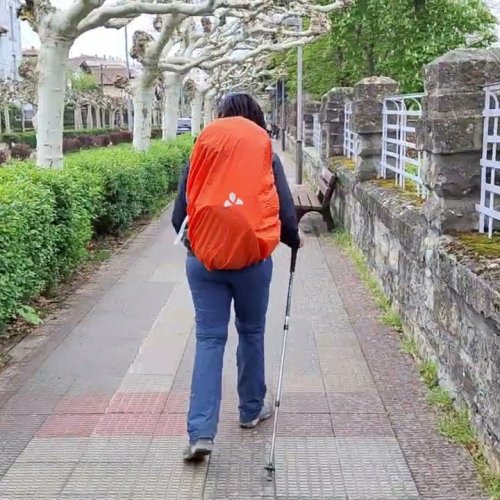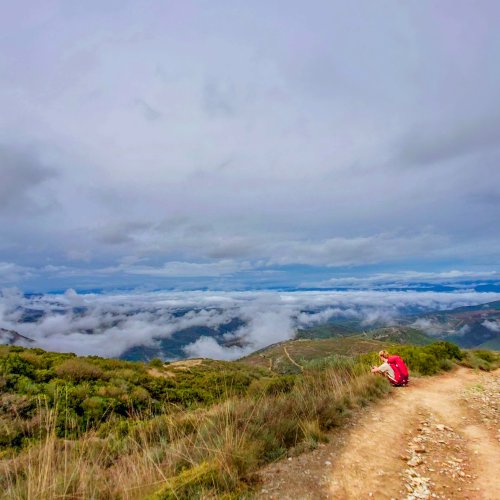D
Deleted member 67185
Guest
I saw that there was some interest in an older thread about shin splints, and thought perhaps re-posting something I had written previously might help with this issue. Especially now that folks are gearing up for the Spring pilgrimage season 
---------------------------------------------------------------------------
I put this together to provide help to those who wish to minimize the risk of the unpleasantness of shin splints while on Camino.

Warm Up -- ALWAYS warm up prior to exercise and stretch well after exercise.
After Walking
Stretch your calves, shins, and Achilles tendon after every walk. Tight muscles make the shin work harder to lift your foot.
When Walking
Choose a good walking surface. Avoid concrete if possible. If you walk on a road with an obvious camber, try walking out and back on the same side of the road to avoid putting too much stress on one leg.
Studies demonstrate that bigger and stronger calf muscles have a lower risk of developing tibial stress fractures. Since tibial stress fractures can be the result of shin splints that haven’t been addressed, it makes sense that strengthening your calves may also help walkers avoid medial tibial stress syndrome.
Consider the following strength exercises to help strengthen those calves and the surrounding muscles to help prevent shin splints:
Calf Raises
Standing with your feet slightly apart, raise up onto your toes, pause for 2 seconds, and lower back down. Complete two sets of 15 repetitions.
Toe Walks
Standing on your tiptoes, walk forward 15 yards. Complete two sets of 15 yards.
Foot Pumps
Lie down with your legs straight out in front of your body and your toes pointed toward the sky. In a pumping motion, point your toes back towards your body and then back to the original position. Complete two sets of 20 repetitions.
Heel Drop
Standing on a stair or elevated platform, put your weight on your right foot while lowering your right heel past 90 degrees. Slowly raise back up and repeat before switching sides. Complete two sets of 10 repetitions on each side.
If you have shin pain, you may need to take a day or two of rest and start back more slowly.
Remember: RICE -- Rest, Ice, Compression and Elevation. Ibuprofen is often recommended. There are health risks with this product. So, don't use without doing your own research.
BE AWARE -- There are a couple of related lower leg injuries which some folks may think are shin splints, but require medical intervention:
Compartment Syndrome
Pain on the lower anterior may be compartment syndrome, a swelling of the muscles within the compartment. Increased pressure compromises the area's circulation and function of the tissues in that space. Symptoms include pain, unusual nerve sensations, and muscle weakness. This condition requires a physician's diagnosis and surgical decompression may be necessary.
Stress Fracture
Another cause of pain in the lower leg is a stress fracture. If you have a definite spot of sharp pain when you run your hand along your shin the pain may be a stress fracture. A horizontal rather than vertical line of pain is another indicator and stress fractures normally feel better in the morning after a night of rest. A bone scan is necessary for diagnosis.
---------------------------------------------------------------------------
I put this together to provide help to those who wish to minimize the risk of the unpleasantness of shin splints while on Camino.
Warm Up -- ALWAYS warm up prior to exercise and stretch well after exercise.
- Walk at a slower pace at the beginning of each walk.
- Then perform ankle circles: rotate ankle ten times in one direction, then ten times in opposite direction.
- Next, do some toe points: point toes, then flex foot - ten times on each foot to get your muscles loosened up.
- Do the ankle circles and toes points several times each day or write the alphabet in the air with your toes.
After Walking
Stretch your calves, shins, and Achilles tendon after every walk. Tight muscles make the shin work harder to lift your foot.
When Walking
Choose a good walking surface. Avoid concrete if possible. If you walk on a road with an obvious camber, try walking out and back on the same side of the road to avoid putting too much stress on one leg.
- Increase your mileage and speed gradually. The general rule of thumb is to increase mileage at a rate of 10% each week.
- Be sure that you are not over striding.
- Over striding occurs when you take longer steps to increase speed without running. Lengthen the stride in back, rather than in front, to improve power and efficiency in your stride. An overstriding walker has their front foot too far out in front of body. You want instead for your forward foot to contact the ground closer to your body.
- Your stride should be longer behind your body, where your toe is pushing off, rather than out in front of your body. This is because your forward leg has no power, while your back leg is what is pushing you forward.
- Be Aware of Your Step Rate
- Increasing your cadence or step rate will significantly reduce impact forces. Focus on striking beneath your center of mass and avoid stepping out in front of your body—this will also prevent over striding and braking—to lessen the load placed on the tibia.
Studies demonstrate that bigger and stronger calf muscles have a lower risk of developing tibial stress fractures. Since tibial stress fractures can be the result of shin splints that haven’t been addressed, it makes sense that strengthening your calves may also help walkers avoid medial tibial stress syndrome.
Consider the following strength exercises to help strengthen those calves and the surrounding muscles to help prevent shin splints:
Calf Raises
Standing with your feet slightly apart, raise up onto your toes, pause for 2 seconds, and lower back down. Complete two sets of 15 repetitions.
Toe Walks
Standing on your tiptoes, walk forward 15 yards. Complete two sets of 15 yards.
Foot Pumps
Lie down with your legs straight out in front of your body and your toes pointed toward the sky. In a pumping motion, point your toes back towards your body and then back to the original position. Complete two sets of 20 repetitions.
Heel Drop
Standing on a stair or elevated platform, put your weight on your right foot while lowering your right heel past 90 degrees. Slowly raise back up and repeat before switching sides. Complete two sets of 10 repetitions on each side.
If you have shin pain, you may need to take a day or two of rest and start back more slowly.
Remember: RICE -- Rest, Ice, Compression and Elevation. Ibuprofen is often recommended. There are health risks with this product. So, don't use without doing your own research.
BE AWARE -- There are a couple of related lower leg injuries which some folks may think are shin splints, but require medical intervention:
Compartment Syndrome
Pain on the lower anterior may be compartment syndrome, a swelling of the muscles within the compartment. Increased pressure compromises the area's circulation and function of the tissues in that space. Symptoms include pain, unusual nerve sensations, and muscle weakness. This condition requires a physician's diagnosis and surgical decompression may be necessary.
Stress Fracture
Another cause of pain in the lower leg is a stress fracture. If you have a definite spot of sharp pain when you run your hand along your shin the pain may be a stress fracture. A horizontal rather than vertical line of pain is another indicator and stress fractures normally feel better in the morning after a night of rest. A bone scan is necessary for diagnosis.









